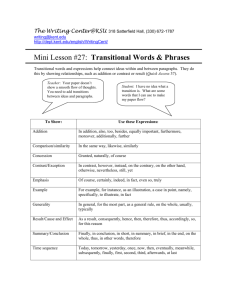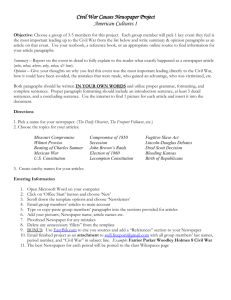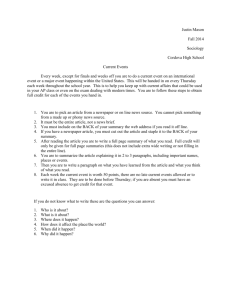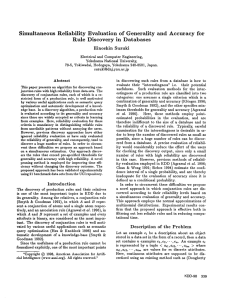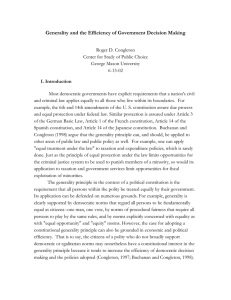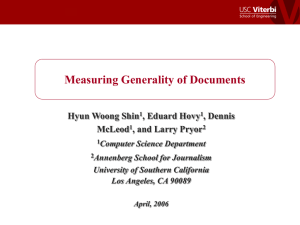Assignment Feedack and Exam Preparation
advertisement
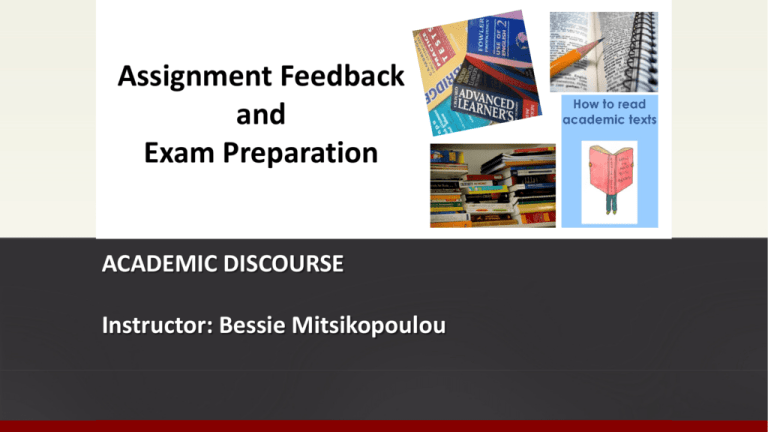
Assignment Feedback and Exam Preparation ACADEMIC DISCOURSE Instructor: Bessie Mitsikopoulou Parts of the final exam Task 1: Outlining and Summarizing Task 2: Writing an academic text (e.g. an absract) on the basis of a popular (e.g. newspaper) text Task 3: Interpretation of Data TASK 1 Sample Tasks TASK 1 (30 points) (suggested time: 40 minutes) The following text has been adapted from an article published in ‘Computers and Composition’ journal (2007, issue: 3, volume 24) entitled ESL students’ experiences of online peer feedback, by Martin Guardado. Read the text carefully in order to identify the main points it presents. Then I. produce a formal outline of the differences between traditional and e-peer feedback, II. on the basis of your outline, prepare a summary (of about 150 words) by paraphrasing adequately, III. using the information provided above, write a full reference for the article. Preparing for Task 1 What to pay attention • You may be asked to prepare a global or a selective summary 1. Global summary (summarize the whole text) 2. Selective summary (summarize part of a text) • Please note that you must first read the text and then, on the basis of the given instructions, decide what you are asked to do • Read the given text two to three times before you start preparing your outline • Pay attention the format of your outline: it reveals the logic of the text Outlining and Summarizing • Attention: First prepare your outline and then on the basis of this outline write your summary • The points included in the outline should be the ones that should be included in the summary, as well • Read the instructions carefully and then read the text once: what are you asked to do? A global or a selective summary? Make sure you identify the differences between these two. The instructions will tell you what to look for in the text. They will not tell you whether you should prepare a global or a selective summary. This is what you should figure it after you have read the instructions and the text. It’s part of the task requirements to make this right decision. FORMAL OUTLINE degrees of generality I. (first level of generality) A. (second level of generality) 1. (third level of generality) 2. (third level of generality) B. (second level of generality) 1. (third level of generality) II. (first level of generality) A. (second level of generality) 1. (third level of generality) B. (second level of generality) FORMAL OUTLINE format & indentation I. Topic sentence or main idea A. Major point (provides information about topic) 1. Subpoint (describes major point) a. Supporting details (for subpoint) FORMAL OUTLINE an example I. Extrasensory perception A. definition: means of perceiving without use of sense organs 1. three kinds a. telepathy: sending messages b.clairvoyance: forecasting the future c. psychokinesis: perceiving events 2. current status a. no current research to support b. impossible for some psychologists c. door open to future What not to do Frequent mistakes • • • • • Do not reproduce the original with numbers before it Do not write full sentences (phrase outline) Do not write a list of bullets or dashes (-) Do not write an outline of one thing and a summary of another Do not write the summary and then the outline General remarks to remember • When paraphrasing, make sure that you keep the same meaning as that of the source E.g. The July 2013 California bar exam were taken by 230 law school graduates who started two weeks before the exam and finished it after the release of the results four months later • Spend time preparing your outline, it will help you write a good summary • Make sure you do not include details in your summary TASK 2 Sample Tasks TASK 2 (30 points) (suggested time: 40 minutes) The following newspaper article appeared in The Guardian reporting on recent scientific findings. Read it carefully and adopt the identity of one of the researchers mentioned in the newspaper article to • write an extract of the original research article published in the Journal of Scientific Evolution, • suggest an academic journal article title for your research article. SELECT only strictly scientific information. Make sure you PARAPHRASE any information borrowed from the original. (word limit: 150 words) TASK 1 (30 points) (suggested time: 40 minutes) The following newspaper article appeared in The Telegraph, reporting on scientific (medical) research findings. Read it carefully and on the basis of the information offered below, reconstruct the (academic) journal extract and (suggest) a title in no more than 200 words: focus on strictly scientific information and include in-text references (by using sources mentioned in the newspaper article). Make sure you paraphrase any information borrowed from the original. How we refer to researchers • Media text Peter Styles, the president of the Geological Society John Mc Closkey of the Univeristy of Ulster in Coleraine Nick Ambraseys, a seismologist at Imperial College London Prof McCloskey’s group • Academic text Styles (2003) Mc Closkey (2004) Ambraseys (2002) Use academic vocabulary (1) • Informal expressions: – ‘a lot of’. • Academic: ‘a substantial number of’ – ‘a great deal of information’. • Academic: ‘an increased amount/plethora of information’ – ‘massive information’. • Academic: ‘extensive information’ – ‘whether they are good enough at what they do’ • Academic: ‘whether their skills are adequate for the job’ Use academic vocabulary (2) • Problematic use of formal expressions: – ‘…it is noticed a significant point in the literature…’ – ‘However, there has not been given so much attention…’ – ‘As Bowden (1993) puts is, the majority of people…’ • The expression ‘puts it’ is most often followed by a quotation and not a paraphrase. – ‘Research’ is mostly used in the singular. Use academic vocabulary (3) • Attention should be paid to the use of appropriate phrases: – – – – ‘Infants’ does not mean the same thing as ‘children’. ‘A great amount of parents’ (number) ‘Isolated children’ is not the same as ‘children from isolated areas’. ‘Reported directly’ does not mean the same thing as ‘reported immediately’. How to write an academic text from a popular (e.g. newspaper) text What to search in the newspaper text Information about: • The topic of investigation • The aims of the study • The methodology used in the study (e.g. questionnaires, interviews, etc) • Main findings of the study • Conclusions of the study How to write an academic text from a popular (e.g. newspaper) text • • • • What your academic text should include TOPIC & PURPOSE: start you text by introducing the author’s purpose, thesis or hypothesis which forms the basis of reported research METHODOLOGY: an indication of the experimental design (information on data, procedures, methods, sample) SUMMARY OF RESULTS: main findings should be presented or solutions to the problem CONCLUSIONS: interpretation of results and drawing of inferences (not your own). Indication of the implications and applications of the study TASK 3 Sample Tasks TASK 1 (30 points) (suggested time: 40 minutes) TASK 1 (30 points) (suggested time: 40 minutes) The tables below are taken from a study by Alan Hirvela (2001) which examines the possibility of incorporating reading material into academic writing courses. The 38 non-native advanced learners of English who took part in this study ranked a variety of English texts in terms of how difficult or enjoyable to read they were. Table 1 provides information on ranking texts in terms of difficulty and Table 2 information on ranking the same texts in terms of enjoyment. The numbers shown in each column represent the number of learners who selected the ranking presented in the particular column. Study the tables and write a text • describing some of the findings they present and • explaining the findings you have selected to describe by taking into account (some of) the possible explanations offered below (word limit: 200 words). Bar chart (or histogram) This is a type of chart, which contains labeled horizontal or vertical bars showing a piece of information and an axis. The numbers along the side of bar graph compose the axis. Pie chart A pie chart is a type of a circle graph which shows how this whole quantity is broken into parts. Line graph A line graph is a way of representing two pieces of information, which is usually related and vary with respect to each other. Table Interpretation of data task Prepare a well structured essay Your response to the task on interpretation of data should be in the form of a wellstructured essay which consists of an introduction, main body paragraphs and a conclusion. Introductory paragraph a) Introduce the general topic of the study and refer to the kind of information reported in the graph/table; refer to the source (in-text documentation) appropriately, e.g. In a study conducted by Hall (1998)… b) Describe the graph/table, e.g. the horizontal axis presents…, the vertical axis….(Jordan, unit 11) Interpretation of data task Main body paragraphs 1. Plan carefully the information you will put in each main body paragraph 2. Present the main significant findings of the graph/table. Do not attempt a linear presentation of the graph/table. Remember that you do not need to describe all information on the graph/table. Interpretation of data task Use generalizations + factual language Change numbers and percentages to generalizations and qualification. However, do not use cautious language when you report research findings since they present factual information. Use possible explanations + cautious language Explain the findings presented in the graph/table using some of the possible explanations given to you (do not add your own explanations). Link the following explanations to the findings by using cautious language Interpretation of data task Use transitions Throughout your main body paragraphs use linking words to indicate the sequence of significant findings (e.g .first, second, moreover, furthermore, on the contrary) and their findings (e.g. interestingly, surprisingly, as expected, it is worth mentioning) Use the language of comparison Use comparative forms in order to compare (present similarities) and contrast (present differences) information from the graph/table. Interpretation of data task Expressions for graph description Use vocabulary which refers to the table/graph, describes change/trend and the information in the table/graph, e.g. • upward/downward trend/fluctuations • to level off, to reach a peak, to reach a plateau, to remain constant • rapid/dramatic/sharp increase/rise/grow • steady/moderate/small/slight/ gradual rise • sudden/abrupt decrease/fall/drop/decline Interpretation of data task Conclusion • In this paragraph briefly refer to the main findings that may be drawn form the table/graph and sum up discussion. Use appropriate vocabulary e.g. In short, in brief, to summarize, in conclusion, on the whole, etc

